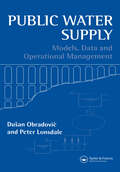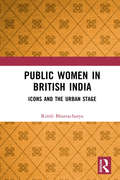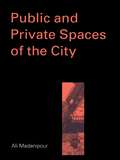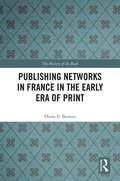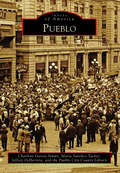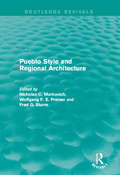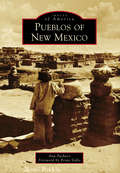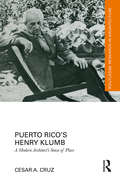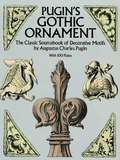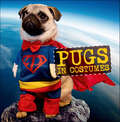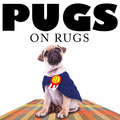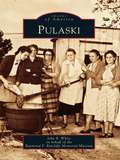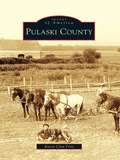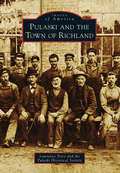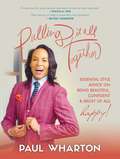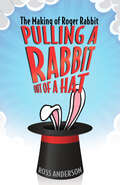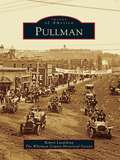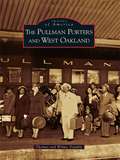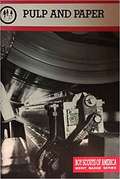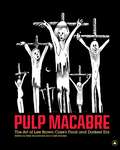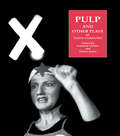- Table View
- List View
Public Water Supply: Models, Data and Operational Management
by Peter Lonsdale Dusan ObradovicProfessionals in the water supply industry are faced with a mass of technical information about how best to use new technologies to improve the efficiency of their supply operations.This book will help explain practical problems and potential solutions clearly and comprehensively to readers who may not be familiar with the latest developments in IT
Public Women in British India: Icons and the Urban Stage
by Rimli BhattacharyaThis book foregrounds the subjectivity of ‘acting women’ amidst violent debates on femininity and education, livelihood and labour, sexuality and marriage. It looks at the emergence of the stage actress as an artist and an ideological construct at critical phases of performance practice in British India. The focus here is on Calcutta, considered the ‘second city of the Empire’ and a nodal point in global trade circuits. Each chapter offers new ways of conceptualising the actress as a professional, a colonial subject, simultaneously the other and the model of the ‘new woman’. An underlying motif is the playing out of the idea of spiritual salvation, redemption and modernity. Analysing the dynamics behind stagecraft and spectacle, the study highlights the politics of demarcation and exclusion of social roles. It presents rich archival work from diverse sources, many translated for the first time. This book makes a distinctive contribution in intertwining performance studies with literary history and art practices within a cross-cultural framework. Interdisciplinary and innovative, it will appeal to scholars and researchers in South Asian theatre and performance studies, history and gender studies.
Public and Private Spaces of the City
by Ali MadanipourThe relationship between public and private spheres is one of the key concerns of the modern society. This book investigates this relationship, especially as manifested in the urban space with its social and psychological significance. Through theoretical and historical examination, it explores how and why the space of human socities is subdivided into public and private sections. It starts with the private, interior space of the mind and moves step by step, through the body, home, neighborhood and the city, outwards to the most public, impersonal spaces, exploring the nature of each realm and their complex, interdependent realtionships.A stimulating and thought provoking book for any architect, architectural historian, urban planner or designer.
Publikumsschwund?: Ein Blick auf die Theaterstatistik seit 1949
by Rainer GlaapDurch den teils massiven Publikumsschwund nach der Pandemie stellt sich die Frage, ob diese als Brandbeschleuniger gewirkt hat für bereits vorhandene Trends. Der Autor geht dem nach anhand der Besuchszahlen bis zur letzten vollständigen vorpandemischen Spielzeit 2018/19. Er zeigt historische Zeitreihen zu Sparten- und Personalentwicklung, Vertriebskanälen und den Einnahmen. Die Theaterstatistik des Bühnenvereins dient vielen Entscheidungsträgern als Grundlage für z.B. kulturpolitische Steuerungen, obwohl sie nicht die komplette deutsche Theaterlandschaft abbildet. Deshalb beleuchtet der Autor weitere Anbieter. Da die Theaterstatistik große kulturpolitische Bedeutung hat, gibt es zum Schluss einige Vorschläge für die Zukunft.
Publishing Networks in France in the Early Era of Print (The History of the Book)
by Diane E. BootonThis book examines commercial and personal connections in the early modern book trade in Paris and northwestern France, ca. 1450–1550. The book market, commercial trade, and geo-political ties connected the towns of Paris, Caen, Angers, Rennes, and Nantes, making this a fertile area for the transference of different fields of knowledge via book culture. Diane Booton investigates various aspects of book production (typography and illustration), market (publishers and booksellers), and ownership (buyers and annotators) and describes commercial and intellectual dissemination via established pathways, drawing on primary and archival sources.
Pudsey: A Pup Star's Story
by PudseyLast year, a dog danced his way into the history books as the first canine winner of Britain's Got Talent. On their way to the title, Pudsey and his owner Ashleigh Butler won over Walliams, delighted Dixon, stole the heart of Holden, and utterly captivated Cowell. They charmed the nation, too - with millions of families tuning in to see them take the crown.As a young pup, Pudsey always knew he was somehow different to other puppies. While his brothers and sisters contented themselves with chasing their tails, he sat apart, hoping for something more. Pudsey: A Pup Star's Story tells the story of his incredible, inspirational journey, straight from the dog's mouth.
Pudsey: A Pup Star's Story
by PudseyLast year, a dog danced his way into the history books as the first canine winner of Britain's Got Talent. On their way to the title, Pudsey and his owner Ashleigh Butler won over Walliams, delighted Dixon, stole the heart of Holden, and utterly captivated Cowell. They charmed the nation, too - with millions of families tuning in to see them take the crown.As a young pup, Pudsey always knew he was somehow different to other puppies. While his brothers and sisters contented themselves with chasing their tails, he sat apart, hoping for something more. Pudsey: A Pup Star's Story tells the story of his incredible, inspirational journey, straight from the dog's mouth.
Pueblo (Images of America)
by Charlene Garcia Simms Jeffrey Deherrera Maria Sanchez Tucker Pueblo City-County Library DistrictAt the confluence of the Arkansas River and Fountain Creek, Native Americans were the first to inhabit Pueblo and its surroundings. Pueblo means "village" in Spanish, appropriate for an area that was settled in the early 1800s by people from present-day New Mexico with Spanish and Native American roots. A trading post established in 1842 was named "El Pueblo." The gold rush of 1858 attracted the first influx of people who saw more opportunity in Pueblo than in the goldfields. With its vision to become a great city with railroads, a steel mill, and smelters, Pueblo was soon known as the "Pittsburgh of the West." Employment and business opportunities invited emigrants from all over the world, creating a diverse city populated with people of many ethnicities. Pueblo has persevered through natural disasters and economic turmoil, building a thriving and resilient community through each chapter of its history.
Pueblo Style and Regional Architecture (Routledge Revivals)
by Wolfgang F. Preiser Nicholas C. Markovich Fred G. SturmFew architectural styles evoke so strong a sense of place as Pueblo architecture. This book brings together experts from architecture and art, archaeology and anthropology, philosophy and history, considering Pueblo style not simply architecturally, but within its cultural, religious, economic, and climate contexts as well. The product of successive layers of Pueblo Indian, Spanish, and Anglo influences, contemporary Pueblo style is above all seen as a harmonious response to the magnificent landscape from which it emerged. Pueblo Style and Regional Architecture, first published in 1990, is a unique and thorough study of this enduring regional style, a sourcebook that will inform and inspire architects and designers, as well as fascinate those interested in the anthropology, culture, art, and history of the American Southwest.
Pueblos of New Mexico (Images of America)
by Ana Pacheco Brian ValloAs early as 1851, photographers journeyed along the arduous Santa Fe Trail on horseback and in covered wagons on a quest to capture the magnificent vistas on film. In the ever-changing light of New Mexico's landscape, they photographed the faces of the Pueblo People and helped to document their ancient, unimaginable world. They became witness to millennia of history. New Mexico's first inhabitants are believed to have descended from the Anasazi, the largely nomadic group that settled along the Colorado Plateau around 200 AD. Most likely, drought conditions brought the population centers of the Anasazi villages located in the Four Corners of Colorado, Utah, Arizona, and New Mexico to settle along the Rio Grande Valley of New Mexico and the Mogollon Rim of Arizona in 1300 AD.
Puerto Rican Chicago (Images of America)
by Wilfredo CruzPuerto Ricans have a long history in Chicago. Beginning in the 1920s, a handful of middle-class Puerto Rican families sent their daughters and sons to study at prestigious universities in the city. While most returned to Puerto Rico, migration to Chicago peaked during the 1950s and 1960s. Enticed by the prospect of a better life for their families and future generations, thousands of Puerto Ricans came to Chicago in search of a brighter tomorrow. They came to Chicago as American citizens, yet still faced rampant discrimination and prejudice. In 1950, there were only 255 Puerto Ricans in Chicago; today, there are over 113,000. Chicago is home to a thriving Puerto Rican community, and its members continue to make important contributions to the political, educational, social, and cultural institutions of Chicago.
Puerto Rico’s Henry Klumb: A Modern Architect’s Sense of Place (Routledge Research in Architecture)
by Cesar A. CruzThis book follows Henry Klumb’s life in architecture from Cologne, Germany to Puerto Rico. Arriving on the island, Klumb was a one-time German immigrant, a moderately successful designer, and previously a senior draftsman with Frank Lloyd Wright. Over the next forty years Klumb would emerge as Puerto Rico’s most prolific, locally well-known, and celebrated modern architect. In addition to becoming a leading figure in Latin American modern architecture, Klumb also became one of Frank Lloyd Wright’s most accomplished protégés, and an architect with a highly attuned social and environmental consciousness. Cruz explores his life, works, and legacy through the lens of a sense of place, defined as the beliefs that people adopt, actions undertaken, and feelings developed towards specific locations and spaces. He argues that the architect’s sense of place was a defining quality of his life and work, most evident in the houses he designed and built in Puerto Rico. Puerto Rico’s Henry Klumb offers a historical narrative, culminating in a series of architectural analyses focusing on four key design strategies employed in Klumb’s work: vernacular architecture, the grid and the landscape, dense urban spaces, and open air rooms. This book is aimed at researchers, academics, and postgraduate students interested in Latin American architecture, modernism, and architectural history.
Pugin's Gothic Ornament: The Classic Sourcebook of Decorative Motifs with 100 Plates (Dover Pictorial Archive)
by Augustus C. PuginThis classic sourcebook of decorative motifs contains 100 plates of royalty-free Gothic designs, meticulously reproduced from rare 19th-century engravings. Many are floral and foliate designs rendered from panels, capitals, borders, brackets, friezes, grotesques, and other decorative elements from such architectural landmarks as New College Chapel at Oxford and Rouen Cathedral.
Pugs in Costumes
by Virginia WoofFrom haute couture Oscar dresses and character classics, superheroes to inanimate objects, there isn't a creature on earth that can rock a costume quite like a pug. With over 100 full color, candid photographs of these adorable dogs in outfits ranging from adorable to hysterical to downright absurd, this book is a pure delight for animal lovers of all stripes.Packed with 128 pages of color photographs, some of the pugs you'll meet in this volume include:- Scarlett O'Pugra- Bob Pugley- Pugzilla- Chewpugca and Pug Vader- Evita Pugron- The Ba HumPug!And many, many more.
Pugs on Rugs
by Jack RussellWhat is it that makes pugs so lovable? Is it their doleful eyes? Their down-turned mouths? Furrowed brows? While they may look sad, they’ve certainly found their place in our homes and our hearts. Now the adorable creatures have a new home, sitting on rugs in 43 amusing photographs! What could be cuter?Pugs on Rugs celebrates different pugs on different rugs. The dog might be walking, sitting, or sleeping and the rug could be Persian, Aztec, or oriental, but the image is guaranteed to be cute and funny!People have been obsessed with pugs for centuries and each of this small book’s spreads features a photograph (or montage) alongside an amusing caption and a fascinating fact about the history and characteristics of this unique breed.Did you know that the first pugs were brought from China to Europe to serve as guard dogs? Or that a famous pug named Pompey once saved a Dutch prince from assassination? Have you heard about the eighteenth-century German secret society dedicated to the pug in which new members initiated themselves by wearing a collar, scratching at the door, and kissing the rear end of a giant porcelain pug? Yes indeed, pug lovers are an interesting breed and this volume is sure to get them laughing with delight.From bullish to pitiful, Pugs on Rugs is a fantastically fun book featuring some of the snuggliest pugs you’ve ever seen.
Pulaski
by Raymond F. Ratcliffe Memorial Museum John B. WhiteIn 1854, the agrarian area known as Pulaski was bisected by the Virginia and Tennessee Railroad, which brought with it access to new markets, reduced isolation created by the New River, and heavy industry. The 1870s saw the restoration of an economy decimated by war and the incorporation of Dublin and Newbern. The Pulaski Agricultural and Mechanical Association, incorporated in 1872 to promote "enterprise, industry, and thrift among the citizens," was forced to raise funds from the very Philadelphia capitalists who had laid claim to county mineral lands. By 1886, Pulaski City, a classic boomtown, became a microcosm of industrialization in the Central Appalachians. The change created a struggle between the land's agrarian past and industrialized future. Images of America: Pulaski provides glimpses into the rich history of this land. This collection of nearly 200 photographs helps tell the story of those owners of land and industry, those who labored for self-sufficiency, and those who sought to give their children a better life.
Pulaski County (Images of America)
by Karen Clem FritzFor centuries the shimmering waters of the historic Tippecanoe River have quietly marked the history of rural Pulaski County as the stream winds through the heart of the county's landscape, its banks lined with lush woods and rich farmlands. The river was the lifeblood of the Potawatomi Indians who fished its waters and canoed home to camps along the shores. They were followed by pioneer hunters and trappers lured by plentiful wildlife. Early settlers harnessed the river's energy to run saw- and gristmills. Later the Tippecanoe attracted weekend and summer visitors from the city looking for some quiet fishing and peaceful reflection. Pulaski County was established in 1839. Dotted with quaint towns, family farms, and locally owned businesses and light industry, the county has been shaped by a heritage of hard work, simple pleasures, neighborliness, and a determined self-sufficiency that comes of relative isolation. It is a rich and increasingly rare bucolic prospect--nourished by a vigilant river.
Pulaski and the Town of Richland
by Lawrence Petry Pulaski Historical SocietyIn 1801, the first settlers to the Pulaski and Richland area arrived on the eastern shores of Lake Ontario. These communities were shaped by notable personalities, including early residents Nathan Tuttle, Benjamin Winch, and the Mathewson family; tavern owner Pliny Jones; store owner Capt. John Meacham; businessman Charles Tollner; banker Robert Ingersoll; and philanthropist John Ben Snow. They built businesses and industries, shops and homes, and schools and churches that impacted and defined the town. Relying on the area's natural resources, the Salmon River was harnessed to power mills and later lured thousands of fishermen to its waters. The Selkirk Lighthouse became a prominent landmark at the mouth of that river.
Pulling It All Together: Essential Style Advice on Being Beautiful, Confident & (Most of All) Happy!
by Paul WhartonEveryone looks in the mirror and sees imperfections, even models and celebrities. But you don’t need to spend money on expensive skin treatments and spa visits. In Pulling It All Together, Paul Wharton shares the secrets of styling teams and the tricks photographers use to turn everyday women into supermodels. Wharton offers shopping, grooming, and lifestyle tips that will have you feeling drop-dead gorgeous and ready to take on the extraordinary adventures and all the good things life has in store. In the book you’ll find advice on: Fashion: dressing slimmer, how to accessorize, and, of course, shoes Skin care: exfoliation, masks, and more Makeup: foundation, mascara, and everything in between When you take the time to pull your look together, it frees up your mind to think more clearly and focus on what’s in front of you. An expert in front of and behind the camera, fashion and beauty consultant, lifestyle expert, and an entrepreneur with skin and hair care lines, Wharton is pivotally positioned to share keen insight and wisdom to make the world more beautiful one person at a time.
Pulling a Rabbit Out of a Hat: The Making of Roger Rabbit
by Ross AndersonWho Framed Roger Rabbit emerged at a nexus of people, technology, and circumstances that is historically, culturally, and aesthetically momentous. By the 1980s, animation seemed a dying art. Not even the Walt Disney Company, which had already won over thirty Academy Awards, could stop what appeared to be the end of an animation era. To revitalize popular interest in animation, Disney needed to reach outside its own studio and create the distinctive film that helped usher in a Disney Renaissance. That film, Who Framed Roger Rabbit, though expensive and controversial, debuted in theaters to huge success at the box office in 1988. Unique in its conceit of cartoons living in the real world, Who Framed Roger Rabbit magically blended live action and animation, carrying with it a humor that still resonates with audiences. Upon the film’s release, Disney’s marketing program led the audience to believe that Who Framed Roger Rabbit was made solely by director Bob Zemeckis, director of animation Dick Williams, and the visual effects company Industrial Light & Magic, though many Disney animators contributed to the project. Author Ross Anderson interviewed over 140 artists to tell the story of how they created something truly magical. Anderson describes the ways in which the Roger Rabbit characters have been used in film shorts, commercials, and merchandising, and how they have remained a cultural touchstone today.
Pullman
by The Whitman County Historical Society Robert LuedekingLocated at the confluence of three creeks, amid the rich agricultural soil of Eastern Washington's Palouse region, Pullman seemed destined to flourish. From its founding in the 1880s, growth was spurred by the discovery of artesian wells, its selection as the location of the State Agricultural College, and the building of rail lines through the town. Pullman, named for railroad car manufacturer George Pullman, became a thriving center of commerce, agriculture, and education. Today Pullman remains a vibrant commercial agricultural center, built upon wheat, peas, and lentils, with a downtown nestled among four hills. Pullman is home to cutting edge technology companies and a major research institution, Washington State University. Its rich heritage in agriculture, education, and technology guarantees its future as a highly successful 21st century city.
Pullman Porters and West Oakland, The
by Thomas Tramble Wilma TrambleA hub of transportation and industry since the mid-19th century, West Oakland is today a vital commercial conduit and an inimitably distinct and diverse community within the Greater Oaklandmetropolitan area. The catalyst that transformed this neighborhood from a transcontinental rail terminal into a true settlement was the arrival of the railroad porters, employed by the Pullman Palace Car Company as early as 1867. After years of struggling in labor battles and negotiations, the Brotherhood of Sleeping Car Porters Union became the first African American-led union to sign a contract with a large American company. The union's West Coast headquarters were established at Fifth and Wood Streets in West Oakland. Soon families,benevolent societies, and churches followed, and a true community came into being.
Pulp And Paper (Merit Badge Series)
by Boy Scouts of America StaffOutlines requirements for pursing a merit badge in pulp and paper, including instruction in the history of paper making, how fibers are derived from wood, how paper is made, and careers in the pulp and paper industry.
Pulp Macabre: The Art of Lee Brown Coye's Final and Darkest Era
by Mike Hunchback Caleb BraatenNo other artist working in mid-century pulp fiction created work as twisted as Lee Brown Coye. By the 1970s, after surviving a life-threatening illness, Coye would outdo himself, creating lurid illustrations exclusive to rare privately published books and fanzines. <P><P>With nearly one hundred gloriously rendered Coye-penned images, Pulp Macabre showcases Coye's final and darkest era, containing some of the most passionately ghoulish artwork ever made.Mike Hunchback is an enthusiast of various eras of extreme and bizarre underground art, and is currently working on a biography of original Fangoria magazine editor Robert "Uncle Bob" Martin.Caleb Braaten operates Sacred Bones Records, which has recently teamed with David Lynch to release his new album The Big Dream.
Pulp and Other Plays by Tasha Fairbanks
by Elaine Aston Gabriele GriffinFirst Published in 2004. Routledge is an imprint of Taylor & Francis, an informa company.
